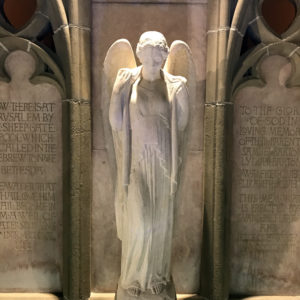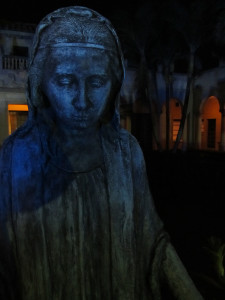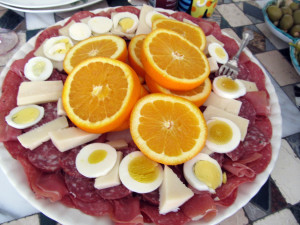I am writing this in a church, which probably is not very reverent of me. It is the overnight watch, as Holy Thursday dissolves into Good Friday. The Easter Triduum. Apologies for my irreverence, and also for years of leading you astray, as I’ve told you for years now that lent, that somber season that leads to Easter, ends with the Easter Vigil Mass on Holy Saturday. Well, that’s not true. It ends, I’ve learnt just tonight, with the Triduum of Maundy Thursday, Good Friday, and Holy Saturday. And so I apologize for years of misinformation.
While I’m pretty good with the secular stuff, I am certainly not your best source for liturgical information. Although I love churches (especially old ones), I have not been a very good churchgoer for a while now. My last time in a church was for Dad’s funeral mass last February, before lent even began, and not since last Easter before that. But I love ceremony and I love tradition, and I love this night. It was my grandma Assunta who taught us the tradition of visiting three churches on Holy Thursday, though three may have been a tradition of her own––visiting seven is more traditional, an Italian tradition coming out of the seven basilicas of Rome and the seven stations of the cross. But we do what we know and three is what I have always known. And there are meditations that we are supposed to reflect upon while we are in those churches. But me, I am a visitor. I like to visit and sit in the company of those I love, and so this is what I do here, too. It may be just me and a few other souls in this dark church tonight, but in my heart all the ones I love are with me, too. My whole family. No one is missing. This is especially important to me this year.
Hide Not Your Light
Tonight is one of the most beautiful nights of the year: Holy Thursday. A quiet and unassuming holiday/holyday, remarkable in its consistency, for the moon is always big and beautiful this night, hauntingly present, a constant companion as we make our pilgrimage in an old tradition that would have us visit three churches over the course of the evening. The world is different at night. Churches glowing from within, moonlight reflecting on columns and limestone figures. Astonishingly quiet, serene stillness.
The actual Holy Thursday mass in most churches comes around sunset. It is the Mass of the Lord’s Supper, commemorating that last supper so often depicted by artists. Jesus began by washing the feet of his disciples, a humble act accompanied by the suggestion that we, too, should not be above doing even the lowest things for others. At supper, he broke bread and passed the cup of wine: the central act of every mass.
The Holy Thursday mass I’ll attend tonight will be trilingual: English, Spanish, and Creole. It’s long and it’s crowded but I love it. It is the one mass each year where folks from so many diverse communities come together. For years I would seek out and sit next to an old Creole woman who reminded me of my grandmother, but I haven’t seen her these past two years, and so I sit there with people I do not necessarily know and I think of my grandmother and the old Creole woman who had no idea she was so important to me.
And so the First Reading will be in one language, the Second Reading in another, and the Gospel in the last of them. If you don’t know the language being spoken, you can read along on your own. And as crowded as it is, still there are two choirs: one singing in English, the other in Creole, coming together, too, for this one night each year. The Creole songs are long and mysterious. One of them is sung to the tune of “My Old Kentucky Home.” They sing in Creole while I remember what I can from Stephen Foster’s song and each year they sing that song, I think of the small scrap of paper found in Stephen Foster’s pocket after he died. On it, he had scribbled five touching words: Dear friends and gentle hearts. That’s exactly how I feel each year at this mass.
The mass ends with the transfer of the Blessed Sacrament to the chapel while the congregation sings the Pange Lingua, acapella. Its more proper name is Pange Lingua Gloriosi Corporis Mysterium, an old hymn written in Latin by St. Thomas Aquinas in the 13th century. “Mysterium” is very appropriate, for this is a night wrapped in mystery and beauty, both of which truly begin once the Pange Lingua is done. There is no real end to the mass. A small bit of chaos ensues as church workers begin to prepare for Good Friday, which is tomorrow. People get up and leave, others mill about, and it’s noisy hustle and hubbub for a good 20 minutes until, eventually, the noise fades away as the church empties to just a few hardy souls who are there to sit. Some are in prayer, some are in reflection. Most, perhaps, are like me: doing some of all those things but also just being part of something bigger than ourselves, as it should be, in the company of others.
The tradition varies, apparently. The one that my grandmother Assunta passed down to us is to visit three churches on this night. But I’ve heard of some people visiting seven churches. Both are magical numbers: 3 for the Trinity, of course, and for the three aspects of the Goddess (virgin, mother, crone), amongst other things, and 7 for more things than you might imagine: the seven sacraments, the seven days of creation, the seven sorrows of Mary, seven loaves and fishes… Still, three churches is plenty. Grandma may have been pious but she was not a martyr.
My pilgrimage each year takes me from my small old church surrounded by the tall buildings of Downtown West Palm Beach, across the lagoon to a grand church in Palm Beach that looks like it’s come out of the Vatican, to a humble church in Lake Worth. I make these rounds each year on this night, sitting, kneeling, remembering those who have gone before us doing this very same thing. This is the value of ceremony and tradition to me: this connection across time and space. And no matter where I go this night, the moon is there tagging along, trusted companion, never tiring, illuminating the night and the trees as much as the churches themselves illuminate their stained glass windows shining out from within. No one after lighting a lamp puts it under the bushel basket, but on the lamp stand, and it gives light to all in the house.
This is a reprint of a chapter written for Holy Thursday, 2014. The sentiment is the same and the moon, full last night, will be joining us as we make that annual pilgrimage. Perhaps the old Creole woman will be back this year. Then, tomorrow, we will do our Easter baking with the rest of the family, preparing the things we love for Sunday’s big dinner. Today’s image was taken one Maundy Thursday at the courtyard at St. Edward’s Church, Palm Beach. The world is different at night, with its distinct mysteries and a haunting beauty not open to us in daylight. Thanks for coming along with me on the journey.–– John
Buona Pasqua
Come noon on Holy Saturday, that is today, lent is over. Or so this was the tradition in my grandparents’ home. The day before was Good Friday and my mother recalls that on Good Friday, the home was in a state of mourning, as if there was a wake going on (and back then wakes took place in the home). “You couldn’t turn on the radio,” she says. “You couldn’t even step on the cracks of the sidewalk.” She doesn’t remember whose rule that was, but it was, nonetheless, a Good Friday rule for my mom as a little girl.
But by noon on Holy Saturday, the mood shifted to one of preparation for the next day’s big feast. In their home, the Easter meal was usually lamb: chunks of it braised on the stove with garlic and onion, then mixed with spring dandelion greens, scrambled egg and parsley and grated parmesan cheese. In their dialect from Lucera the dish was called spetsada (and I’m not sure of the spelling, considering this is not true Italian). The lamb and the eggs bring important symbolism to the Easter table, foods we take in that tell the story of spring’s renewal through subtle hints of sacrifice and resurrection.
At Grandma Cutrone’s table, the meal was typically a fancy pasta dish like ravioli. And this typically is what our Easter table holds, too. The ravioli are always homemade and that part of the meal is always preceded by a special Easter antipasto called la fellata. It begins with a large platter (we like abundance, so the larger the better!). First on the platter are paper thin slices of salami and prosciutto, and atop them, rounds of pepperoni and soppresata, sliced hard boiled eggs, wedges of sharp provolone and slices of fresh mozzarella. In the very center goes an Italian basket cheese, which we usually call “cheese in the basket,” but just as my grandparents all spoke their particular dialects of the Italian language, even “basket cheese” seems like a sort of Italian-American dialect. Its proper Italian name might be canestrato, but basket cheese seems its most prevalent name, and the name comes from the cheese being formed inside a basket––once reed but now most often plastic––so that the impression of the basket is apparent in the finished cheese once it is removed from the basket and placed on the table. Sometimes, if the platter is just too close to overflowing, we might place the fresh mozzarella and the basket cheese in a platter of their own. If your fellata is to be truly delicious, you’ll procure all of these items from a good Italian market, rather than from the supermarket. (When’s the last time you had good fresh mozzarella from the supermarket?)
What separates Grandma Cutrone’s version of la fellata from that of my mother’s family is the addition of sliced oranges. Perhaps they began as leftovers from Grandma Cutrone’s St. Joseph’s Day altar in March, for she always placed baskets of oranges at her altar for St. Joseph. No matter how or why, the sliced oranges brighten the platter. They are cut in thick rounds with one slice from the center out to the peel, so that the orange sections can be pulled apart into a big toothy grin. And of course colored eggs and baskets of the taralli that were the focus of the last chapter of the Book of Days. (I included a recipe for taralli there should you be looking for a good Holy Saturday project.)
Getting through the meal at the Easter table at our house takes hours. Like the Easter Vigil Mass that begins at sundown tonight, it is an occasion not for the faint of heart. It is an event for which one brings a hearty appetite for food and for life. And as we toast each other at that table so we toast you: Buona Pasqua a tutti!


